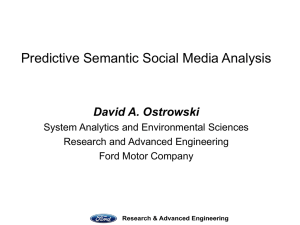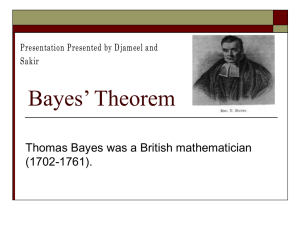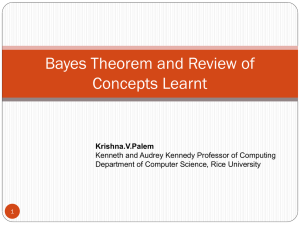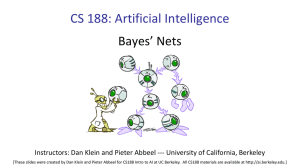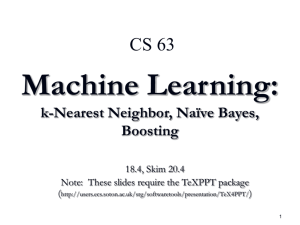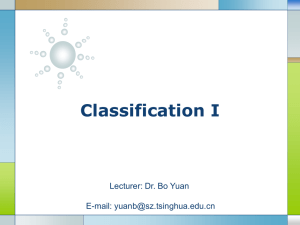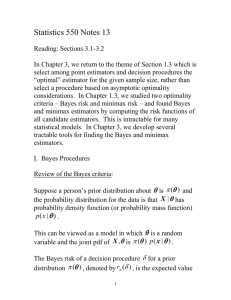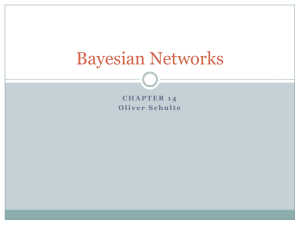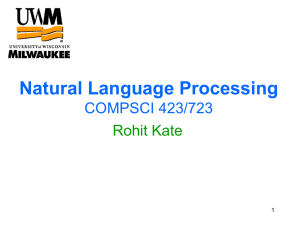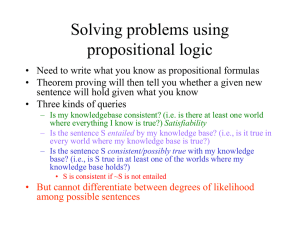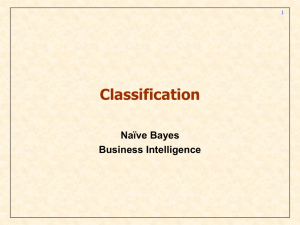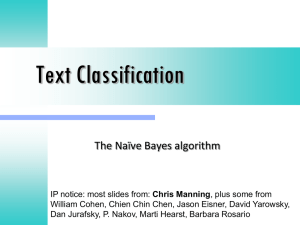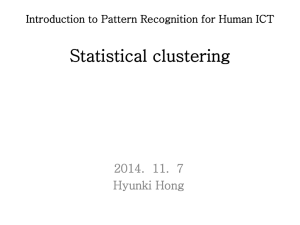Clustering 2 (Chap 7)
advertisement
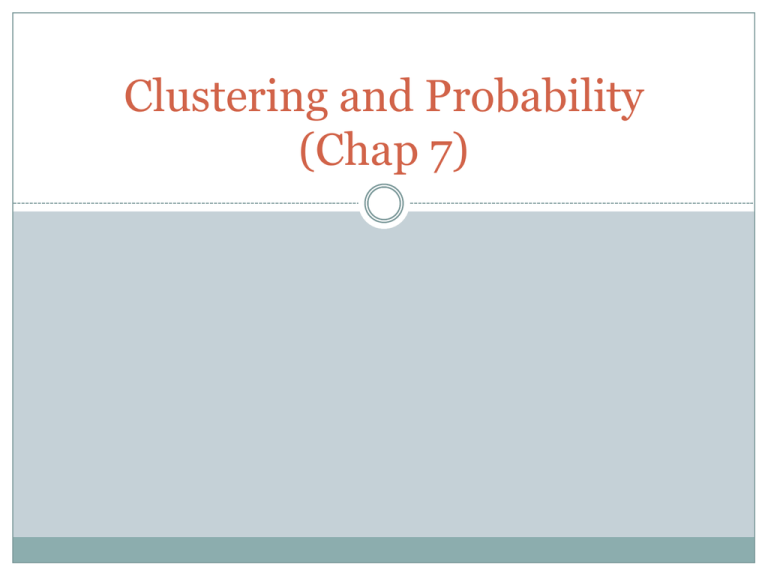
Clustering and Probability
(Chap 7)
Review from Last Lecture
Defined the K-means problem for formalizing the notion
of clustering.
Discussed the K-means algorithm.
Noted that the K-means algorithm was “quite good” in
discovering “concepts” from data (based on features).
Noted the important distinction between “attributes” and
“features”.
Example of K-means -1
Measure 1
Measure 2
Patient 1
1
1
Patient 2
2
1
Patient 3
3
4
Patient 4
4
5
Let initial centroids be C1 = (1,1) and C2 = (2,1)
Example of K-means-2
Measure Measure
1
2
Dist to
C1 (1,1)
Dist to
C2 (2,1)
nearest
Patient 1
1
1
0
1
C1
Patient 2
2
1
1
0
C2
Patient 3
3
4
3.6
3.16
C2
Patient 4
4
5
5
4.47
C2
C1: = (1,1); C2 = ((2+3+4)/3, (1+4+5)/3)) = (3,3.33)
Example of K-means-3
Measure1 Measure2
Dist to
C1 (1,1)
Dist to C2
(3,3.33)
nearest
Patient 1
1
1
0
3.07
C1
Patient 2
2
1
1
2.54
C1
Patient 3
3
4
3.6
0.67
C2
Patient 4
4
5
5
2.10
C2
C1: = ((1+2)/2, (1+1)/2) = (1.5,1); C2 = ((3 +4)/2), (4+5)/2) = (3.5, 4.5)
Example of K-means-4
Measure1 Measure2
Dist to
Dist to C2
C1 (1.5,1) (3.5.4.5)
nearest
Patient 1
1
1
0.5
4.3
C1
Patient 2
2
1
0.5
3.8
C1
Patient 3
3
4
3.35
0.70
C2
Patient 4
4
5
4.61
1.59
C2
C1: = ((1+2)/2, (1+1)/2) = (1.5,1); C2 = ((3 +4)/2), (4+5)/2) = (3.5, 4.5)
Example: 2 Clusters
c A(-1,2)
c B(1,2)
4
(0,0)
c C(-1,-2)
c D(1,-2)
2
K-means Problem: Solution is (0,2) and (0,-2) and the clusters are {A,B} and
{C,D}
K-means Algorithm: Suppose the initial centroids are (-1,0) and (1,0) then
{A,C} and {B,D} end up as the two clusters.
Several other issues regarding clustering
How do you select the initial centroids?
How do you select the right number of clusters ?
How do you deal with non-Euclidean
distance/similarity measures ?
Other approaches (like hierarchical, spectral etc.)
Curse of high-dimensionality.
Question
S-Length
S-Width
P-Length
P-Width
Flower
Small
Medium
Small
Medium
A (SetosA)
Medium
Medium
Large
Large
O(Versicolor)
Medium
Small
Small
Large
I (Virginica)
Large
Large
Medium
Small
A
Large
Small
Medium
Small
?
What should the “prediction” be for the flower ?
Prediction and Probability
When we make predictions we should assign
“probabilities” with the prediction.
Examples:
20% chance it will rain tomorrow.
50% chance that the tumor is malignant.
60% chance that the stock market will fall by the end of the
week.
30% that the next president of the United States will be a
Democrat.
0.1% chance that the user will click on a banner-ad.
How do we assign probabilities to complex events..
using smart data algorithms…and counting.
Probability Basics
Probability is a deep topic…..but for most cases the
rules are straightforward to apply..
Terminology
Experiment
Sample Space
Events
Probability
Rules of probability
Conditional Probability
Bayes Rule
Probability: Sample Space
Consider an experiment and let S be the space of
possible outcomes.
Example:
Experiment is tossing a coin; S={h,t}
Experiment is rolling a pair of dice: S={(1,1),(1,2),…(6,6)}
Experiment is a race consisting of three cars: 1,2 and 3. The
sample space is {(1,2,3),(1,3,2),(2,1,3),(2,3,1),(3,1,2),(3,2,1)}
Probabilities
Let Sample Space S = {1,2,…m}
Consider numbers
pi ³ 0,i =1, 2...m; å pi =1
i
pi is the probability that the outcome of the
experiment is i.
Suppose we toss a fair coin. Sample space is S={h,t}.
Then ph = 0.5 and pt = 0.5.
Probability
Experiment: Will it rain or not in Sydney :
S = {rain, no-rain}
Prain = 138/365 =0.38;
Pno-rain = 227/365
Assigning (or rather how to) probabilities is a deep
philosophical problem.
What is the probability that the “green object standing outside
my house is a burglar dressed in green.”
Probability
An Event A is a set of possible outcomes of the
experiment. Thus A is a subset of S.
Let A be the event of getting a seven when we roll a
pair of dice.
A = {(1,6),(6,1),(2,5),(5,2),(4,3),(3,4) }
P(A) = 6/36 = 1/6
In general P(A) = å pi
iÎA
Probability
The sample space S and events are “sets”.
P(S) = 1;
P(Φ) = 0
Addition:
Often
P(AÈ B) = P(A)+ P(B)- P(AÇ B)
P(AÇ B) º P(AB) º P(A, B)
Complement:
P(Ac ) =1- P(A)
Example
Suppose the probability of raining today is 0.4 and
tomorrow is also 0.4 and on both days is 0.1. What
is the probability it does not rain on either day.
S={(R,N), (R,R),(N,N),(N,R)}
Let A be the event that it will rain today and B it will
rain tomorrow. Then
A ={(R,N), (R,R)} ; B={(N,R),(R,R)}
Rain at least today or tomorrow: P(AÈ B) = 0.4 + 0.4 - 0.1= 0.7
Will not rain on either day: 1 – 0.7 = 0.3
Conditional Probability
One of the most important concepts in all of Data
Mining and Machine Learning
P(A|B) = P(AB)/P(B) ..assuming P(B) not equal 0.
Conditional probability of A given B has occurred.
Probability it will rain tomorrow given it has rained
today.
P(A|B) = P(AB)/(B) = 0.1/0.4 = ¼ = 0.25
In general P(A|B) is not equal to P(B|A)
We need conditional probability to answer….
S-Length
S-Width
P-Length
P-Width
Flower
Small
Medium
Small
Medium
A (SetosA)
Medium
Medium
Large
Large
O(Versicolor)
Medium
Small
Small
Large
I (Virginica)
Large
Large
Medium
Small
A
Large
Small
Medium
Small
?
What should the “prediction” be for the flower ?
Bayes Rule
P(A|B) = P(AB)/P(B); P(B|A) = P(BA)|P(A)
Now P(AB) = P(BA)
Thus P(A|B)P(B) = P(B|A)P(A)
Thus P(A|B) = [P(B|A)P(A)]/[P(B)]
This is called Bayes Rule
Basis of almost all prediction
Latest theories hypothesize that human memory and action is Bayes
rule in action.
Bayes Rule
Prior
Posterior
P(B | A)P(A)
P(A | B) =
P(B)
P(data | hypothesis)P(hypothesis)
P(hypothesis | Data) =
P(data)
Bayes Rule: Example
The ASX market goes up 60% of the days of a year. 40% of the time it stays
the same or goes down. The day the ASX is up, there is a 50% chance that the
Shanghai Index is up. On other days there is 30% chance that Shanghai goes
up. Suppose The Shanghai market is up. What is the probability that ASX was
up.
Define A1 as “ASX is up”; A2 is “ASX is not up”
Define S1 as “Shanghai is up”; S2 is “Shanghai is not up”
We want to calculate P(A1|S1) ?
P(A1) = 0.6; P(A2) = 0.4;
P(S1|A1) = 0.5; P(S1|A2) = 0.3
P(S2|A1) = 1 – P(S1|A1) = 0.5;
P(S2|A2) = 1 –P(S1|A2) = 0.7;
Bayes Rule: Example
We want to calculate P(A1|S1) ?
P(A1) = 0.6; P(A2) = 0.4;
P(S1|A1) = 0.5; P(S1|A2) = 0.3
P(S2|A1) = 1 – P(S1|A1) = 0.5;
P(S2|A2) = 1 –P(S1|A2) = 0.7;
P(A1|S1) = P(S1|A1)P(A1)/(P(S1))
How do we calculate P(S1) ?
Bayes Rule: Example
P(S1) = P(S1,A1) + P(S1,A2)
[Key Step]
= P(S1|A1)P(A1) + P(S1|A2)P(A2)
= 0.5 x 0.6 + 0.3 x 0.4
= 0.42
Finally,
P(A1|S1) = P(S1|A1)P(A1)/P(S1)
= (0.5 x 0.6)/0.42 = 0.71
Example: Iris Flower
F=Flower; SL=Sepal Length; SW = Sepal Width;
PL=Petal Length; PW =Petal Width
Data
Large
Small
Medium
Small
P(F = A) =
P(Data | F = A)P(F = A)
P(Data)
P(F = O) =
P(Data | F = O)P(F = O)
P(Data)
P(Data | F = I )P(F = I)
P(F = I ) =
P(Data)
?
choose the
maximum
Example: Iris Flower
So how do we compute: P(Data|F=A) ?
This is a a non-trivial question…[subject to much
research]
How many times does “Data” appear in the “database”
when F=A.
P(Data | F = A) =
#(Data, F = A)
#(F = A)
In this case “Data” is a 4-dimensional “data vector.” Each
component takes 3 values (small, medium, large). Thus
number of combinations 3^4 = 81.
Example: Iris Flower
Conditional Independence
P(Data|F=A) = P(SL=Large,SW=Small,PL=Medium,PW=Small|F=A)
~= P(SL=Large|F=A)P(SW=Small|F=A)P(PL=Medium|A)P(PW=Small|A)
The above is an assumption to make the “computation
easier.”
Surprisingly evidence suggest that it works reasonably well in practice.
This prediction method (which exploits conditional
independence) is called “Naïve Bayes Classifier.”

